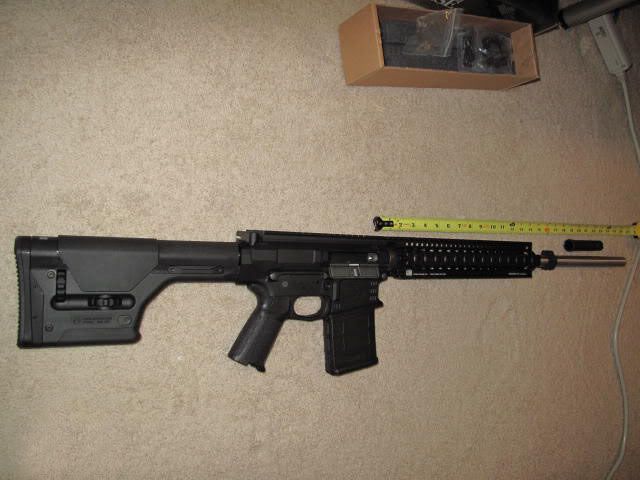Re: Opinions on AR 308 barrel length
<div class="ubbcode-block"><div class="ubbcode-header">Originally Posted By: garandman</div><div class="ubbcode-body"><div class="ubbcode-block"><div class="ubbcode-header">Originally Posted By: Sig685</div><div class="ubbcode-body">
You actually think that the muzzle flash is due to powder burning at the muzzle?
</div></div>
Yes, genius.
Hot gasses DO NOT make a "big ass blast" to quote your insipid post.
Burning powder does.</div></div>
You might want to refer to this page for some information on what constitute muzzle flash or blast:
http://www.navweaps.com/index_tech/tech-090.htm
There are endless sites describing similar information and even Wikipedia does a great job here:
http://en.wikipedia.org/wiki/Muzzle_flash
But I find the first one I listed provides a more detailed explanation.
Here are some of the highlights from that page:
"This flash consists of at least the following five components:
1) Muzzle Glow
2) Primary Flash
3) Intermediate Flash
4) Secondary Flash
5) Sparks
Then the site goes on to detail the cause of each of the components."
Here is what they say about muzzle glow:
"1) Muzzle Glow is usually a reddish white glow or tongue of flame at the muzzle that appears just prior to shot ejection and persists after shot ejection until the chamber pressure drops significantly. The initial glow is usually the result of <span style="font-weight: bold">hot, highly compressed gases (unburned propellants) leaking past the projectile</span> driving band and is brightest in a worn gun. These gasses are hot enough to emit radiation in the visible light band. A "Cold Gun" with its lubricated barrel generally shows less muzzle glow than does a "Hot Gun" with its expanded barrel."
Here is what they say about the primary flash:
"2) Primary Flash occurs after the projectile has exited the muzzle and <span style="font-weight: bold">is caused by those propellant gases exiting the muzzle</span> behind the projectile. These are hot enough to emit large amounts of visible radiation but cool rapidly as they expand away from the muzzle."
Here is what they say about the intermediate flash:
"3) Intermediate Flash consists of a reddish disc, slightly dished towards the gun, which appears about three inches (7.5 cm) from the muzzle of a small-caliber weapon and about 20-25 calibers from the muzzle for larger caliber weapons. Intermediate Flash occurs at the time of shot ejection and persists until the chamber pressure drops. It is brightest at the edge nearest the gun and gradually fades as the distance from the muzzle increases. This flash is <span style="font-weight: bold">due to a Mach shock wave created by the escaping gasses</span> and projectile which, with its attendant pressure rise, causes the propellant gases to attain a temperature almost equal to the chamber temperature and so become self-luminescent."
Here is what they say about the secondary flash:
"4) Secondary Flash appears beyond the zone of the intermediate flash and is a rather ragged vortex of yellowish white flame. This is a result of the ignition of the combustible mixture of <span style="font-weight: bold"> propellant gases and atmospheric oxygen caused by the turbulent mixing occurring at the boundary of the gas jet as it leaves the muzzle</span>. The ignition of this mixture would appear to be initiated by its exposure to the high temperature of the intermediate flash."
There is even a picture. You also want to look at the Wikipedia page I listed.
Here are some highlights from it:
"Muzzle flash can be broken down into five distinct components.[9]
Muzzle glow is a reddish glow that is visible before the bullet leaves the barrel. Muzzle glow is created by superheated gases that have leaked past the projectile and have exited the barrel.
The primary flash is caused by propellant gases exiting the firearm behind the bullet. Although amongst the brightest of the flashes, the heat of the primary flash dissipates quickly and thus is no longer visible.
The intermediate flash is caused by shock waves created by the high speeds of the escaping gases and projectile, and appears as a reddish disc shape in front of the muzzle.
The secondary flash appears farthest from the muzzle as a large white or yellow flame. Secondary flash is caused by the mixture of fuel-rich gases and oxygen in the atmosphere surrounding the muzzle.[10]
Following the dissipation of the muzzle flash, partially unburnt powder or other heated materials can be ejected from the muzzle and appear as sparks."
<div class="ubbcode-block"><div class="ubbcode-header">Quote:</div><div class="ubbcode-body">A little 7th grade science - in order to have FIRE, you need three things - 1. Heat 2. Oxygen 3. Fuel. If all the powder is burned up 5" from the chamber THERE IS NO FUEL AND THERE IS NO POSSBILITY OF FIRE AT THE MUZZLE.
Ergo, NOT all the powder is burned up 5" from the chamber. </div></div>
If you are a handloader, I suggest the following test. A powder charge for a .308 is about 45 grains of powder. Let's say that 10% is still not burned and comes out the muzzle and is ignited by something (you do not provide that information so, I'll leave it up to you. All you know is that it's certainly not the hot pressurized gasses. So, anyway put 4.5 grains of powder on the ground and ligth it with a match. I wonder if the result will be anywhere close to an actual muzzle blast.
<div class="ubbcode-block"><div class="ubbcode-header">Quote:</div><div class="ubbcode-body">Ergo, you prove the validity of my sig line.
"Better to keep your pie hole shut, and be thought a fool, than to open it and confirm to the world that you are."
Seriously, dude, quit while you are only WAY behind. </div></div>
Truly words to live by.






